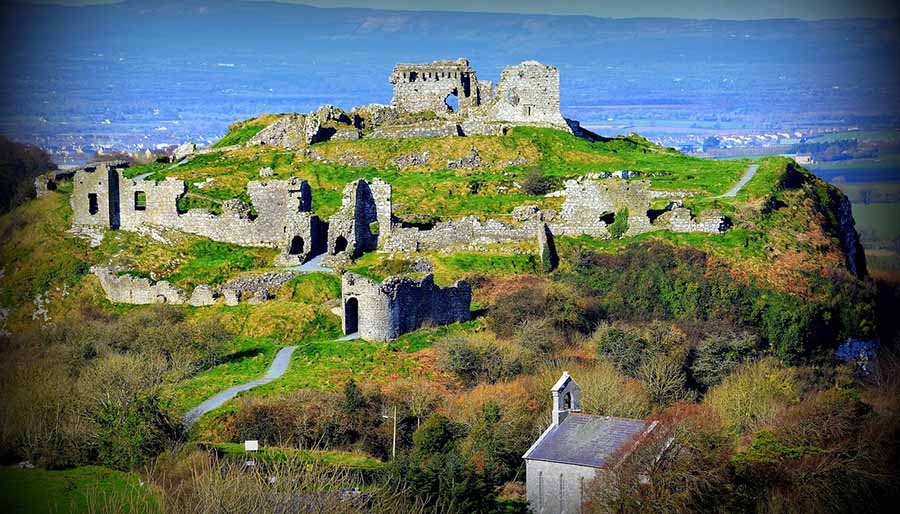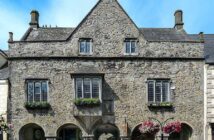
The Rock of Dunamase, located in County Laois, is a dramatic hilltop fortress located on a limestone outcrop, offering stunning views and a rich historical tapestry spanning over a millennium. A National Monument under the care of the Office of Public Works (OPW), it’s a compelling stop for those exploring Ireland’s Ancient East.
- The Rock of Dunamase, or Dún Másc (Fort of Másc), dates back to the 9th century when an early Christian hill fort was plundered by Vikings in 842/845. It became a key Anglo-Norman stronghold in the late 12th century after Diarmuid Mac Murrough, King of Leinster, included it in his daughter Aoife’s dowry for her marriage to Strongbow in 1170. The castle passed to William Marshal through his marriage to Aoife’s daughter, Isabel, and was fortified into a formidable fortress. It later belonged to the O’Moore family from the 14th century until its destruction, likely during the Cromwellian invasion of 1650, though some damage may have occurred later. In the late 18th century, John Parnell attempted to restore it as a banqueting hall, incorporating architectural elements from other ruins.
- Ruins and Features: Visitors can explore remnants of the castle, including the gatehouse, outer barbican (a defensive ditch), curtain walls, and the Great Hall at the peak, protected by cliffs on three sides. Notable features include “murder holes” for defense and traces of early medieval dry-stone walls. An information panel near the base provides a historical overview and a drawing of the castle’s former grandeur, aiding imagination.
- Archaeological Finds: Excavations in the 1990s uncovered over 5,500 objects, including a 9th-century silver penny, offering insights into the site’s early medieval past. A small lime kiln near the gatehouse, likely from the 19th century, shows how locals repurposed castle stones for agricultural lime.
- Free and Unguided Access: The site is open 24/7, year-round, with no admission fee, making it an accessible stop for spontaneous visits. It’s unguided, so visitors can explore at their own pace, though the OPW advises caution due to uneven terrain and steep paths. An audio guide is available via the Laois County Council website for deeper historical context.
- Guided access: The rock is best experienced through knowledgeable local guides such as Trudy Carmody +353 (85) 107 0650 trudy@experiencinglaois.com
- Scenic Views: Standing 46 meters above the plains, the Rock offers panoramic vistas of the Laois countryside, with the Slieve Bloom Mountains visible in the distance. The lack of walls enhances these unobstructed views, ideal for photography, especially at sunrise or sunset.
- Quiet and Uncrowded: Unlike busier attractions like the Rock of Cashel, Dunamase is off the beaten track, often allowing visitors to have the site to themselves. Reviews highlight its serene, magical atmosphere, recommended for what Tourism Ireland marketing department calls the “culturally curious” and those seeking a peaceful escape.
- Short Walk: A gravel path leads from the car park to the ruins, with a casual looped walk around the site taking 15–20 minutes. The climb to the top involves steep, rocky terrain and narrow gates, which may challenge those with mobility issues or wheelchairs. Dogs are allowed on a leash.
- Practical Details: On the N80 between Portlaoise and Stradbally, near a small church (Eircode: R32E170), about 4 miles east of Portlaoise. It’s a 50-minute drive from Kilkenny City, 1 hour from Dublin, 1.5 hours from Limerick, and 2 hours from Cork, easily accessible via the M7 motorway (Exit 16).
- Parking: Limited roadside parking is available near the church, fitting about a dozen cars. Visitors can see their vehicles while climbing, adding a sense of security, though the small lot may fill up during peak times.
- A visit typically takes 30–60 minutes, depending on exploration and photography. Combining it with nearby attractions like Timahoe Round Tower (10 km south) or Emo Court (8.4 km away) makes for a fuller day.
- Nearby Attractions: The site is part of Ireland’s Ancient East, near Ballykilcavan Brewery, Heywood Gardens, and the Donaghmore Famine Workhouse Museum. Traditional pubs like Treacy’s on The Heath offer a taste of local culture.
Atmosphere and Appeal:
- The ruins’ rugged state, combined with their commanding hilltop position, evoke tales of Vikings, Normans, and Gaelic clans. Visitors often describe feeling transported to Ireland’s turbulent past, with the site’s isolation augmenting its mystique. Its appearance in the film Leap Year (with CGI enhancements) adds a pop culture touch, though the real site is more understated yet equally captivating.
- Reviews praise the lack of commercialization—no “money-making schemes” or crowds—making it a “hidden gem” for those seeking authentic history and natural beauty.
- Accessibility The steep, rocky paths and narrow entry gate make the site less suitable for wheelchairs or those with mobility issues. An electric scooter was suggested by one visitor with an injury, but no such facilities exist.
- Limited Interpretation: Some visitors wish for more storyboards or detailed signage to enrich the experience, as the single information panel provides basic context. The audio guide helps but requires pre-downloading.
- Weather Consideration: The exposed hilltop can be windy or muddy, so sturdy shoes and weather-appropriate clothing are advised.
Plans for visitor centre and paid access:
- Laois County Council is spearheading an ambitious “Dunamase Heritage Visitor Experience” under the working title “High Castle,” aligning with Ireland’s Ancient East “Castles and Conquests” theme. Announced in May 2025, these plans aim to transform the Rock of Dunamase into a major tourism draw, attracting 18,000 paying visitors annually. Key developments include:
- Visitor Centre in Portlaoise: A new visitor centre is planned at the old Ha’penny Schoolhouse on Church Avenue, Portlaoise, featuring immersive audio-visual (AV) exhibits showcasing the Rock’s history, including Viking raids, Norman conquests, and Irish resistance. Archaeological artifacts from the 1990s excavations, such as the 9th-century silver penny, will be displayed. The centre will serve as a hop-on/hop-off point for visitors.
- Interpretive Signage: New signage will be added outside the site boundary, including a map of paths, points of interest, and visitor centre advertisements. Additional signs will be placed along the path to the Barbican Gate, designed to avoid impacting the archaeological site (e.g., no concrete foundations).
- Shuttle Bus Service: A proposed electric shuttle bus, a 16-seater funded by the Climate Action Fund, will connect the Portlaoise visitor centre to the Rock of Dunamase. This service aims to improve access, reduce parking strain, and link the site with nearby attractions like Timahoe Round Tower and Emo Court, encouraging longer stays in Laois.
- Guided Tours and Evening Experiences: Guided tours will be introduced, offering in-depth storytelling about the Rock’s role in monastic, Irish, and Norman history. These tours will complement the AV experience at the visitor centre, providing a cohesive narrative.
- Evening experiences, such as banqueting, dance, and musical entertainment, are planned to enhance visitor dwell time and align with the Laois Tourism Strategy. These events will leverage a new car park currently under archaeological assessment to ensure no historical damage.
- Regional Connectivity: The strategy emphasizes linking Dunamase with other Ireland’s Ancient East sites, including Kilkenny Castle (50 minutes away), the Rock of Cashel, Birr Castle, and King John’s Castle. This positions Dunamase as a “crossroads” destination, drawing visitors from Kilkenny, Offaly, Tipperary, and beyond to extend the tourism season.
- Archaeological Dig for New Car Park: An archaeological dig is underway at the site of a proposed expanded car park to ensure no historical artifacts are disturbed. This development will support increased visitor numbers and facilitate shuttle bus operations.
Visitor Expectations:
- Implementation Timeline: The visitor centre, shuttle bus, and guided tours are in the planning and tender phase, with no confirmed opening date. Visitors should check www.laoistourism.ie or www.heritageireland.ie for updates on when these enhancements will be available.
- Preservation Concerns: The OPW and Laois County Council emphasise minimal impact on the archaeological site, avoiding invasive construction. This careful approach may limit the scope of on-site enhancements but preserves the ruins’ authenticity.
- Visitor Expectations: The shift to a paid experience with guided tours and a visitor centre may alter the site’s current charm as a free, unguided “hidden gem.” Some visitors may prefer the existing low-key atmosphere, while others will welcome the enriched interpretation.
A visit to the Rock of Dunamase offers a journey through Ireland’s turbulent past, from Viking raids to Norman conquests, set against breathtaking countryside views. The free, unguided site is recommended for a short, immersive stop, though its steep terrain requires caution. New, the “High Castle” visitor experience promises a state-of-the-art visitor centre in Portlaoise, electric shuttle buses, guided tours, and evening events, aiming to elevate Dunamase’s profile while preserving its archaeological integrity. For the latest updates, visit www.laoistourism.ie.







